- PREVIOUS
- NEXT
April 2020
Tokyo Tramway Beckons Day Trippers
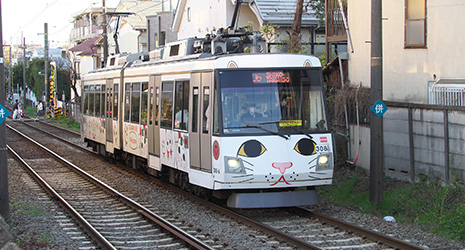
One of Tokyo’s last remaining tramways takes passengers on a fun ride through a part of the city where a taste of the good old days is never far away.
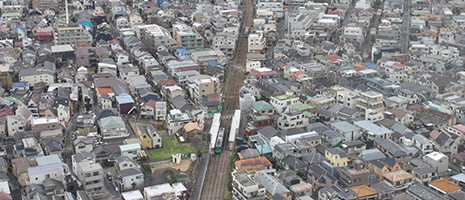
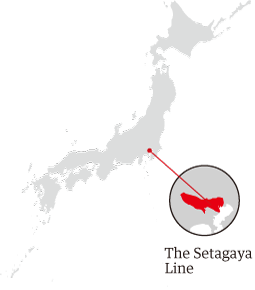
The Setagaya Line operated by Tokyu Railways is a tramway connecting Sangen-Jaya Station and Shimo-Takaido Station in Tokyo’s Setagaya City. Two-carriage trams complete the five-kilometer, ten-station route from end to end in about 17 minutes. Tramways once crisscrossed Tokyo, but services were discontinued one after another as the use of motor vehicles increased. Today, only the Toden Arakawa Line (Tokyo Sakura Tram) and Setagaya Line remain in operation.
Setagaya City, which was a rural area until the Meiji period (1868–1912), developed into a residential area following the relocation of victims of the Great Kanto Earthquake in 1923. The Setagaya Line, which began full-scale operations in 1925, operated as a branch of the Tamagawa Line that connected Shibuya Station and Tamagawa Station (the present Futako-Tamagawa Station in Setagaya City). While the Tamagawa Line between Shibuya and Futako-Tamagawaen was closed in 1969, the line between Sangen-Jaya Station and Shimo-Takaido Station, renamed the Setagaya Line, has continued operations until the present day.
With a population of over 900,000, Setagaya City is a very popular place to live, mainly due to its proximity to central Tokyo, including Shibuya and Shinjuku. The Setagaya Line is characterized by the many housing units and apartments lined up close to the railroad. While the Setagaya Line is a common method of transportation for commuters going to offices, schools or stores, it is also a convenient, popular service for seeing the sights of Tokyo. There are many places to see along the line, such as historic temples and shrines, and shopping streets with a nostalgic atmosphere.
The starting point of the Setagaya Line is Sangen-Jaya Station. The name of the station literally means three teahouses, originating from the fact that there were three teahouses in the area during the Edo period (1603–1867). Today, the district around the station, where hundreds of restaurants are concentrated, is the busiest of the areas served by the line. Next to the station stands the 27-story Carrot Tower, named for its carrot-colored external walls. The building houses facilities such as a public theater, grocery store and offices, and has an observation deck on the 26th floor. With no nearby high-rises, the deck offers magnificent views over the townscape of Setagaya toward the high-rise areas of Shibuya and Shinjuku and, on clear days, Mount Fuji on the horizon.
One of the most popular sightseeing spots along the Setagaya Line is Gotokuji Temple, located five minutes’ walk from Miyanosaka Station. Gotokuji Temple, built in 1480, was a family temple of the Ii Family who ruled the Hikone domain (present day Shiga Prefecture), and whose administrative territory included Setagaya. Legend has it that in the early Edo period, Ii Naotaka, the second lord of the Hikone domain, entered the temple, beckoned by a cat as he passed in front of the temple after hawking. By so doing, he avoided a terrible thunderstorm that suddenly began. This incident is said to be the origin of the maneki-neko, or beckoning cat, a good luck charm well known to Japanese people. More than 1,000 maneki-neko cats of sizes large and small are displayed alongside the Shofukuden house on the temple’s premises. Due to its popularity on Instagram, the spot attracts many visitors from home and abroad. The Setagaya Line even runs streetcars designed to look like maneki-neko, with interiors fitted with beckoning cat-shaped handrails and cat paw marks on the floor.
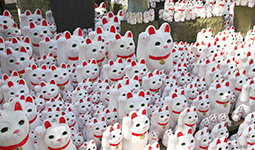
One of the famous shrines in the areas served by the line is Shoin-jinja Shrine. Located three minutes’ walk from Shoin-jinja-mae Station, the Shrine is dedicated to Yoshida Shoin, a philosopher and educator active around the end of the Edo period. Yoshida educated young people at a private school named Shokasonjuku in Hagi City, Yamaguchi Prefecture. Many of his students played leading roles in the Meiji Restoration in 1868. There is a replica of the Shokasonjuku within the shine’s premises.
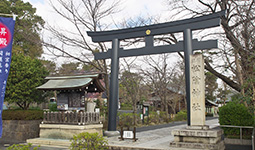
Many events are held in the area served by the Setagaya Line. One is Boroichi, a two-day flea market that takes place twice a year, in January and December. The flea market, which is said to date back more than 400 years, is held on Boroichi Street, three minutes’ walk from Kamimachi Station. More than 700 vendors of used clothes, antiques, toys, daily items, plants, foods and other items set up stall on market days, attracting around 200,000 visitors.
The area also features chic restaurants and cafés offering delicious sweets as well as small shops where friendly staff like to chat with the customers. One attraction of the Setagaya Line is that its ten stations are all located within one kilometer of each other. If you see any shops or locations that draw your interest as you pass, you can hop off at the next station without any worries. A trip on the Setagaya Line helps you feel close to this town and its people.
- PREVIOUS
- NEXT

